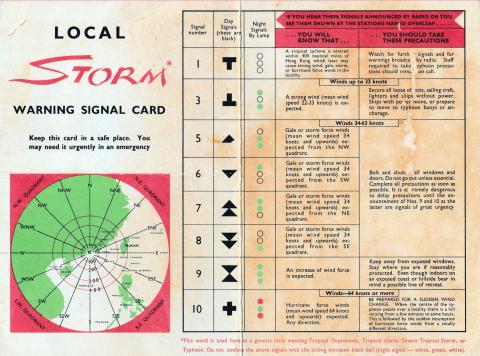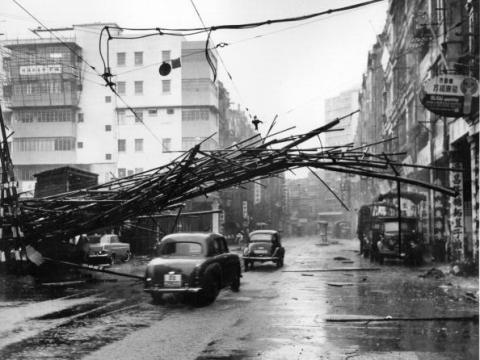As we head into the typhoon season, guest author Peter Kelly remembers the troubles they caused him in 1964, when he was in Hong Kong as a telecoms engineer with the army:
Our busiest time was during the typhoon season. This occurred every year with some years being spectacularly damaging. I had one of those years, with cables being uprooted by anchor chains and mass flooding of many of our manholes.
The warnings would start at number one or two and slowly climb to ten.
1950s Storm Warning Signal Card by Andrew Suddaby
By about six all movement outside had been banned and the city hunkered down to sit out the storm. The wind was hurricane force and the rain torrential. One night we were all turfed out of our beds to tackle a flooded monsoon drain that wound its way down through our barracks. The drain was as big as any canal and had become blocked by debris at the point where it disappeared under the main road. It was overflowing into our main store and we were all out there in the torrential rain armed with long bamboo poles digging into the debris in the hope of dislodging it. Pissing into the wind was an understatement for this operation.
The water was sweeping down the hill basically ignoring any channel by the time we were woken up. My flip-flops took off as soon as I put my feet outside the room and we were all drenched and frozen in about two minutes. However the military does not give up easily so there we all were poking our poles into this collection of bed ends and sideboards in the vain hope of clearing a path for what was practically a semi horizontal waterfall. Thankfully we were allowed to abandon the task before any of us were swept out to sea.
The city was a complete mess after this night. All the scaffolding had been wrenched down from the numerous building projects and vast numbers of ships had been dragged from their moorings. Those on duty during these storms just stayed where they were and carried on until relieved, usually after about three days.
I was caught on duty on a couple of occasions and life at work was chaotic. Circuits would drop out in batches of ten, the three incoming telephone lines would be permanently ringing and the engineering circuit on the go all the time. Our main job, apart from logging the faults and pacifying the users was to ensure the really important circuits were re-routed so that they remained open. This often meant shutting off a perfectly good circuit for one of a higher priority. You can imagine the comment from the local colonel (or more usually his wife) when their phone was cut off to enable a switchover to take place. The threats to “take this up with the General” were very frequent, but always came to nothing.
Each fault was just recorded on a “docket” for attention once the storm had passed. Equally we needed to record all the emergency routing we had created. The outcome of all this was a very major clear up operation the following week. It was however very exciting and called for very quick thinking. The four centres worked closely together and would give a composite sigh of relief once any immediate problem had been solved.
I do remember one Saturday morning during the “clear-up” when I was working on my own with one ear clutching the engineering test phone, the other arguing a point on one of the incoming phones and the other two phones ringing awaiting attention, when a Major appeared on the scene. His wife had sent him down to “sort those buggers out” as her phone had been off for a day or two. He was quite a decent type and waited while I wrestled with the continuous calls. Eventually he just gave up looking somewhat stunned at the amount of work being done by this lone corporal and just left with a wave and a smile. As a PR exercise I think we gained much by his very timely visit. We heard nothing more about his phone, but we did ring him to say it was now back and subtly apologised for the delay. Just sometimes the brass would stumble in on reality.
Peter adds: "I was only in HK from August 64 to Jan 65, working as a shift technician in Force Exchange. Went to the UK on a course expecting to return but was re-posted to S. Wales..................How life takes its turns.
The flooding was no doubt late 1964. I think the typhoon was Ruth or something like that."
Further reading:
- The Force Exchange was located in the underground headquarters known as the Battle Box. The Battle Box was built in the 1930s in Victoria Barracks, but was demolished during the construction of Pacific Place.
- The 1964 typhoon that Peter remembers was most likely Typhoon Ruby.
1964 Scaffolding brought down by 'Typhoon Ruby' is caught by
overhead tram power lines on Des Voeux Road West, by fong.laikuen
- View the timeline of Typhoons in Hong Kong for facts and photos of some of the other powerful typhoons that hit Hong Kong.


Another disaster.